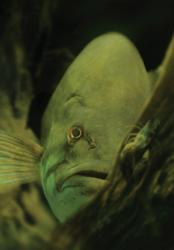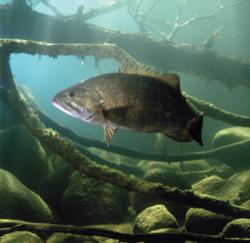Habitual creatures
24-7 account of smallie activities

We are creatures of habit. We do things by routine, by experience – by following the path of least resistance. You do not want to do more work than is necessary. You need to conserve energy. The same can essentially be said for smallmouth bass, too.
Where they take up station is dictated by their surroundings. Generally, they are limited as to how far they can go to find a suitable place to live. Some populations of smallmouth bass are known to travel great distances to find the right habitats in the various seasons. Others are homebodies, staying pretty much their entire lives in a short reach of stream.
But that is looking at a long-term horizon – seasons, or even a lifetime. What about a smallmouth bass’s needs over the course of a day? Where do they go, what do they do and how does their strategy change? Do they follow that path of least resistance over the course of a day? I sought an answer in Arizona’s Black River.
Over the course of a summer, I got in the water with the fish and followed their daily routines. I did not mark individual fish, only where in the river I saw them at given times of day – in full daylight, at twilight and in complete darkness. Though my research did not tell me how an individual fish behaved over time, I made enough observations – in the hundreds – to show what habitats the fish related to at any time of day in the river. Because I spent a great deal of time in the water, I wore an insulated dive suit and used a dive lamp at night.
 I must admit, I had some preconceived notions on what to expect, based on years of fishing for smallmouth bass in small streams in Ohio as well as fishing techniques that I had read about. I had every expectation my research would confirm what was probably already known. To some extent, that did happen. But what the fish did at night was something totally new.
I must admit, I had some preconceived notions on what to expect, based on years of fishing for smallmouth bass in small streams in Ohio as well as fishing techniques that I had read about. I had every expectation my research would confirm what was probably already known. To some extent, that did happen. But what the fish did at night was something totally new.
Dusk and dawn are nothing more than a blending of daytime and nighttime. What better time to chow down on crayfish – a favored fare – than in twilight? Smallmouth bass are sight feeders, and they rely on light to see their prey. In twilight, the crayfish are still out, and the light favors the fish. To take advantage of the easy pickings, smallmouth bass cruise shallower water at dusk and dawn where crayfish can be found. Think about it – you are not going to find the crayfish in swift water. In my study, smallmouth bass were most active in twilight, a time when they moved about the most.
Dusk and dawn last less than two hours, but that brief period can be the most productive smallmouth-bass fishing if you know what to look for. My research showed these river bass tend to relate to water not so deep and not so fast. That is where the crayfish were. Resist fishing the deepest water in the twilight.
This old world keeps spinning around, and dawn gives way to daylight. Given that smallmouth bass are known to be somewhat sensitive to sunlight, it was not any great surprise to find fish in the deepest, most shaded water in peak daylight hours. Again, following the path of least resistance, and in this case, the resistance of river currents pouring downstream, smallmouth bass related to the downstream side of submerged logs, boulders and rock outcroppings. It takes less energy to sit on the lee side of a current break. In the daylight hours, their feeding strategy changed. In keeping with conserving energy, the smallmouth bass usually kept station next to swifter-flowing water – not in it, but alongside it – and let the groceries come to them. They fed on drifting insects, aquatic and terrestrial, and smaller fish. The fish also partitioned themselves vertically – that is, they stacked themselves on top of each other, maybe to take advantage of limited deep water. Thus everyone got a chance at drifting food. The favorite haunts during the daylight were in the deepest of pools near the bottom. That is where the light was most subdued and the current slowest. Sight-feeding fish have a distinct advantage peering from shaded water into sunlit waters, and the smallmouth bass in my study would invariably lurk for food in the shadows, using little energy to get it.
I zipped up my dive suit, pulled my mask over my face, turned on the dive lamp and slipped into the dark water at 1 a.m. What lay there below was surprising – smallmouth bass, all sizes and ages, lying motionless, calm. I had every expectation to find fish, big and small, swimming about hunting food. After all, I had taken some good-sized bronzebacks from Ohio’s Scioto River in the dark of the night, and any bass fisherman knows you can catch them at night. But this was astounding. I found their favorite habitat at night was the shallowest of water, sometimes inches from shore. Smallmouth bass were not actively feeding at night; they did not roam about seeking a chance opportunity to fill their maw. Quite  the contrary, it was not at all unusual to find fish of all sizes literally tucked into crevices in rocks or in the tangles of a logjam. At night they related to the slowest and shallowest water – water that took the least amount of energy to keep a place in the river. Typically at night, I could find the most fish in water less than 18 inches deep, and it makes perfect sense, for a sight-feeding predator – there was no need to wander the waters in search of food they could not see very well. Based on hundreds of observations at night, nearly all fish were in contact with some structure. They did not just orient to it; they were in physical contact with rocks, logs and the stream bottom. Not once did I see a smallmouth bass at night try to catch prey. Crayfish were all around, but they were not hunted.
the contrary, it was not at all unusual to find fish of all sizes literally tucked into crevices in rocks or in the tangles of a logjam. At night they related to the slowest and shallowest water – water that took the least amount of energy to keep a place in the river. Typically at night, I could find the most fish in water less than 18 inches deep, and it makes perfect sense, for a sight-feeding predator – there was no need to wander the waters in search of food they could not see very well. Based on hundreds of observations at night, nearly all fish were in contact with some structure. They did not just orient to it; they were in physical contact with rocks, logs and the stream bottom. Not once did I see a smallmouth bass at night try to catch prey. Crayfish were all around, but they were not hunted.
At dawn, the cycle started all over again. Smallmouths, essentially seeking to break their overnight fast, left cover and started prowling the gravel flats for crayfish.
Smallmouth bass go where they must to conserve energy and put food in the gullet. To consistently catch stream-dwelling smallmouth bass, keep in mind that changing light levels change their literal outlook. It is all about following a path of least resistance and staying well-fed.
Crayfish connection
For low-light action, knowing crayfish behavior may be most important. Fish moderate currents over a cobble bottom – crayfish habitat. Water moving too quickly washes crayfish downstream, so they avoid it. Water moving too slowly drops out sediment, choking would-be crayfish lairs. Bullethead jigs dragged on the bottom or crayfish-colored crankbaits may be the ticket.
Resist the deep pools until it brightens up and the bass retreat there. Look for slack water behind structure next to visible current in shade. Small grubtails and shallow-running crankbaits should produce fish.
When it gets dark, do not go home. Keep fishing, but fish differently. Think shallow, think structure, think slow and think quiet. When the lights go out and the fish are extremely shallow, it is a great time to fish on top with a small stick bait or a Tiny Torpedo.